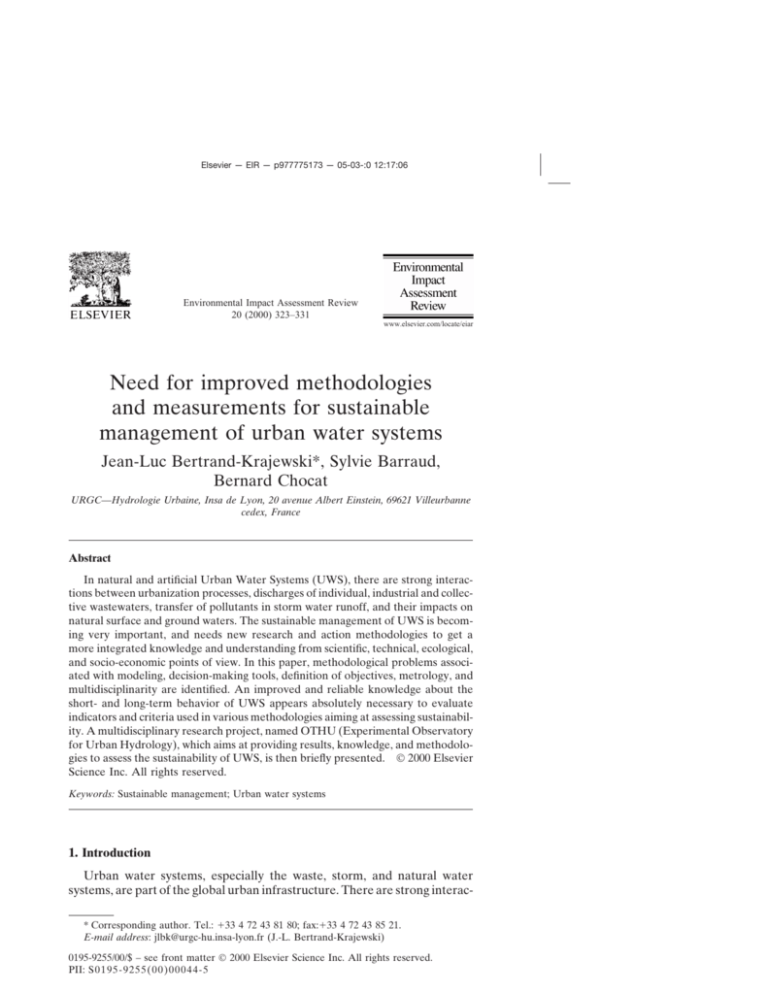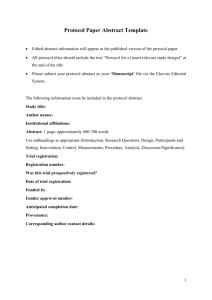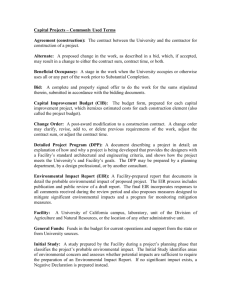
Elsevier — EIR — p977775173 — 05-03-:0 12:17:06
Environmental Impact Assessment Review
20 (2000) 323–331
www.elsevier.com/locate/eiar
Need for improved methodologies
and measurements for sustainable
management of urban water systems
Jean-Luc Bertrand-Krajewski*, Sylvie Barraud,
Bernard Chocat
URGC—Hydrologie Urbaine, Insa de Lyon, 20 avenue Albert Einstein, 69621 Villeurbanne
cedex, France
Abstract
In natural and artificial Urban Water Systems (UWS), there are strong interactions between urbanization processes, discharges of individual, industrial and collective wastewaters, transfer of pollutants in storm water runoff, and their impacts on
natural surface and ground waters. The sustainable management of UWS is becoming very important, and needs new research and action methodologies to get a
more integrated knowledge and understanding from scientific, technical, ecological,
and socio-economic points of view. In this paper, methodological problems associated with modeling, decision-making tools, definition of objectives, metrology, and
multidisciplinarity are identified. An improved and reliable knowledge about the
short- and long-term behavior of UWS appears absolutely necessary to evaluate
indicators and criteria used in various methodologies aiming at assessing sustainability. A multidisciplinary research project, named OTHU (Experimental Observatory
for Urban Hydrology), which aims at providing results, knowledge, and methodologies to assess the sustainability of UWS, is then briefly presented. 2000 Elsevier
Science Inc. All rights reserved.
Keywords: Sustainable management; Urban water systems
1. Introduction
Urban water systems, especially the waste, storm, and natural water
systems, are part of the global urban infrastructure. There are strong interac* Corresponding author. Tel.: ⫹33 4 72 43 81 80; fax:⫹33 4 72 43 85 21.
E-mail address: jlbk@urgc-hu.insa-lyon.fr (J.-L. Bertrand-Krajewski)
0195-9255/00/$ – see front matter 2000 Elsevier Science Inc. All rights reserved.
PII: S0195-9255(00)00044-5
Elsevier — EIR — p977775173 — 05-03-:0 12:17:06
324 J.-L. Bertrand-Krajewski et al. / Environ. Impact Assessment Rev. 20 (2000) 323–331
Fig. 1. Impacts of urbanization on aquatic environments (from [4]).
tions between the urbanization process, the resulting discharges of wastewater due to individual, industrial, and collective water consumption, the
transfer of pollutants in stormwater runoff, and their impacts on natural
surface and ground waters. Some of these numerous interactions are shown
on Fig. 1.
For example, the continuous pumping in the Albien groundwater for
drinking water production under Paris since the 1840s results in a decrease
of the groundwater level of 100 m, and of 10 m only during the last 10
years. The wells were artesian 150 years ago, and now the water shall be
pumped from ⫺40 m. In addition to this quantitative problem, the quality
is now endangered because the decrease of the Albien water level leads
to the transfer of water coming from already polluted adjacent aquifers.
This is particularly important when one knows that the Albien is the ultimate drinking water resource for the Paris Urban Area [11]. In such conditions, the question of the sustainability is very acute.
The pollution of water resources due to effluent discharges is well known
and documented, and will not be developed in this paper. But many other
problems are now becoming significant, with complex conditions and consequences for the urban water systems and their sustainable management.
Among them, the following may be mentioned as examples: (a) the decrease
of groundwater levels leads to some soil destabilization and to risks for
buildings and constructions; (b) the intensive use of aquifer resources for
air conditioning in buildings leads to the increase of its temperature, with
Elsevier — EIR — p977775173 — 05-03-:0 12:17:06
J.-L. Bertrand-Krajewski et al. / Environ. Impact Assessment Rev. 20 (2000) 323–331 325
consequences for the groundwater biocoenosis and biochemical and biological processes affecting the transfer of anthropogenic pollutants through
aquifers; (c) the accelerated transfer of urban runoff and effluents to the
downstream part of the water system leads to the limitation of local infiltration and breaks the water cycle; (d) natural water systems in the urban
environment have been seriously modified and artificialized, associated
with the concepts of “resources” and “receiving water” (see, e.g., [8]), while
more recently the concepts of “patrimony” and “ecological hydrosystems”
have been introduced in the framework of sustainability.
The question of the sustainability of urban water systems and of their
management is becoming very important, and needs new research actions
to get a better knowledge and understanding from scientific, technical,
ecological, and socio-economic points of view. This knowledge is absolutely
necessary for any methodology aiming at assessing the sustainability of
urban water systems by means of indicators and criteria, which should be
based on reliable field data. Two integrated approaches are then necessary:
one in the field of time and space scales, one in the field of multidisciplinarity.
2. Limitations of previous approaches
The necessity of an integrated and sustainable management of urban
water systems led researchers to develop two complementary approaches
and methodologies: modeling and decision making tools.
2.1. Modeling
To manage and/or improve urban water systems, many models have
been developed and proposed. The implicit rule is that models will help
to get information about the behavior of the systems at a lower cost than
field measurements. However, this initial hypothesis (or belief) is not verified. For example, many tens of models have been developed since the end
of the 1960s to simulate production and transfer of pollutants in urban
drainage systems [3]. As the phenomena are very complex and interdependent, many parameters are necessary to calibrate the models, even the most
simple ones. Due to the lack of sufficient and validated experimental data
(because of technical and financial reasons given in the next section), these
models cannot be really calibrated, tested, and verified. To calibrate them,
large amounts of data are required that could sometimes be sufficient to
make decisions without using the models but simply by analyzing the data.
It is then difficult to choose the best models and approaches. Some
comparisons have shown that most complicated models do not give the
best results (e.g., [19]). However, the basic trend consists to develop new
models that are more and more complicated and based on the reductionist
Elsevier — EIR — p977775173 — 05-03-:0 12:17:06
326 J.-L. Bertrand-Krajewski et al. / Environ. Impact Assessment Rev. 20 (2000) 323–331
approach [1]. The confusion between complication and complexity could
perhaps explain this difficulty.
Another problem is that models are frequently sectorial or monodisciplinary. So they fail to give valuable results to make decisions for urban water
systems characterized by integrated interrelations.
As a final remark, it should also be mentioned that many models are
based on the stationarity hypothesis and on short-term processes. This
is also a possible cause of their failure in the urban environment where
stationarity is not really observed. The diachronic (i.e., long-term) evolution
of urban water systems should be taken into account in the framework
of sustainability.
2.2. Decision making
This approach tries to improve the processes that facilitate the choice
of drainage and sewerage strategies with close links with urban planning.
The assistance to decision making requires: (a) a physical representation
of technical systems to facilitate their modeling. However, it should be
noticed that decision aiding may be based on models that are not completely
formalized. In such an approach, any qualitative information can be useful.
For example, if it is not possible to attribute a numerical value to the
impact of discharges on the aquatic environment, one can use a qualitative
representation (the discharges lead to limited, moderate, or severe pollution) or an ordinal one (the discharge X is less polluted than the discharge
Y). Nevertheless, qualitative information, if it is not accurate, shall have a
high degree of certainty to be useful and relevant; (b) a representation of
the actors who influence or take part in the decision-making process. This
representation allows an accounting for various criteria and promotes negotiated solutions or decisions. Thanks to this approach, a methodological
framework for integrated approach has been defined and some operational
tools were produced that accounted for complexity [13,16,18,21].
However, decision aiding declined during the last years in the field of
urban hydrology. Following reasons could explain this decline. Existing
tools for decision aiding have frequently been built for urbanization development. Methods have consequently been devoted to the interactions between the city and its infrastructure. More recently, the natural environment
has been recognized as a significant part, especially in the framework of
sustainable management and development. This introduces additional complexity, while environmental assessment is faced with the lack of sufficient
and reliable data. To solve these difficulties, methodologies have been
based either on the analysis of existing data collected for limited, local,
and short-term studies but abusively extrapolated or generalized, or on
poorly reliable indicators and criteria assumed to be usable to interpret
and qualify trends and/or relationships. Two main consequences result from
Elsevier — EIR — p977775173 — 05-03-:0 12:17:06
J.-L. Bertrand-Krajewski et al. / Environ. Impact Assessment Rev. 20 (2000) 323–331 327
these simplifications: (1) the risk to make decisions based on very limited
or not representative information; and (2) the impossibility to evaluate
properly environmental criteria leads to consideration that all strategies
are equivalent from the environmental point of view, and to implicitly
suppress the environmental aspects in the decision-making process [5].
3. Methodological problems
Three groups of methodological problems have been identified that
significantly contribute to the above limits and difficulties by hindering a
proper assessment of indicators and criteria for sustainability. No significant
progress will be observed in the integrated and sustainable urban water
management if these bottlenecks are not solved.
3.1. Clear definition of research and operational objectives
The development of good quality field measurements and information
turns out to be essential. However, one of the encountered difficulties
relates to setting objectives of monitoring programs. Taking into account
the stakes, it appears very important to precisely define the objectives of
measurements and to clearly identify the anticipated results and the analysis
of data to be acquired. In other words, the first question to be answered
is not “what do we want to measure?,” as one is often tempted to do, but
rather, “what question do we want to answer?.” It is obvious that the
necessary means of measurement are extremely different whether one
wants to monitor the operation of a plant, to detect dysfunction, to improve
the plant, or to check the conformity of its operation compared to legal
thresholds and requirements, or even to study the factors leading to dysfunction.
The definition of objectives is especially important in urban hydrology
because monitoring programs must be multidisciplinary and carried out in
collaboration with operators. This preliminary reflection is essential for the
monitoring efficiency and also to guarantee a sound functioning between
involved partners to avoid misunderstanding about mutual benefits.
It also makes it possible to avoid the temptation of “inventories” (“let
us measure a lot of things and we will see what conclusions could be
drawn”). Obviously, this practice does not give very efficient results: the
exhaustiveness of data is never guaranteed, this solution is economically
not realistic, and much information risks to be unused.
The definition of objectives remains a difficult exercise, which constitutes
in itself a significant part of any research program. As already mentioned,
objectives can be expressed as questions that the monitoring program has
to answer. It is, however, important to make legitimate their relevance by
means of questions like: (a) who should get the monitoring results, and
Elsevier — EIR — p977775173 — 05-03-:0 12:17:06
328 J.-L. Bertrand-Krajewski et al. / Environ. Impact Assessment Rev. 20 (2000) 323–331
who else is interested in them? Are the identified objectives materially and
economically realistic? What are the appropriate space and time scales?
How can the objectives be considered as achieved?
3.2. Concerted and multidisciplinary measurements
Urban water systems and their sustainable management need a multidisciplinary and integrated approach at various time and space scales. Many
difficulties are due to the fact that measurements are not concerted and
cannot be compared and merged from different research communities (urban hydrologists, limnologists, ecologists, operators of drainage systems,
geotechnicians, etc.): (a) time and space scales are very different and sometimes not compatible; (b) the descriptors are different, for example, BOD5
(Biological Oxygen Demand in 5 days) is usually measured in sewers, but
COD (Chemical Oxygen Demand) in treatment plants and TOC (Total
Organic Carbon) in surface waters; (c) sampling and analytical protocols
are different and sometimes even not compatible.
Integrated view and understanding are then impossible or at least very
limited. These difficulties have been recognized and analyzed. Some efforts
have been devoted since the second half of the 1990s to a multidisciplinary
approach that started with the proposed use of common state variables
and descriptors for urban water systems modeling [14,20].
3.3. Quality of the metrology
As any other natural science, urban hydrology, defined as the science
of the production, transfer, and impacts of water and pollutants on urban
aquatic environment, is based on field observations and measurements. It
is not possible to manipulate the research subject (the urban area and the
associated aquatic environment) and to modify it in the framework of
the experimental design methodology. On the contrary, and due to the
numerous and successive different states and conditions of the urban water
systems (the first stochastic variable is the rainfall process), researchers
need to multiply observations in a permanently revised approach, where
measurements and observations are critical to get knowledge, to elaborate
hypothesis by induction and to test them with other observations, to design
and assess operational devices, and to evaluate the state and the evolution
of urban water systems.
In such a process, the metrology is a crucial element. However, for both
technical and financial reasons, field measurements in urban water systems
are limited in space and time, while many decisions based on insufficient
and not representative data are made that concern and affect the urban
water systems in usually not reversible conditions. And these decisions
frequently involve investment and operation costs that are far beyond the
costs of field measurements.
Elsevier — EIR — p977775173 — 05-03-:0 12:17:06
J.-L. Bertrand-Krajewski et al. / Environ. Impact Assessment Rev. 20 (2000) 323–331 329
The metrology, as used in many industrial domains, with systematic
sensor calibration and assessment of uncertainties, is usually not part of
the technical and cultural background of many researchers in urban water
systems (at least in France). For example, it is very frequent that flow rates
in sewer systems are known with an (in)accuracy of ⫾50 to ⫾100%, because
minimum calibrations and verifications are not carried out, and because
inappropriate sensors are used in inadequate measurement locations. Measurements of pollutant flows and masses are more uncertain: systematic
errors for suspended solids concentrations have been observed ranging
from ⫺70 to ⫹300% for primary sampling (i.e., sampling in the sewers),
of about 10% for secondary sampling (i.e., constitution of a mean sample
from primary samples), and of about 20% for analytical errors [6]. The
sampling errors are always the most important ones in the sampling and
analytical process. However, the investment ratio is about 1 for 1,000 in
favor of analysis [10]. The main explanation is the ignorance of the sampling
errors. A rational and scientific sampling theory exists [9,10], and demonstrates that usual samplers do not produce representative samples. However, very rare efforts have been done to develop more representative
samplers [7] or to seriously assess the nonrepresentativity of actual sampling
protocols [2,15,17].
Other aspects are also very important and usually underestimated: (1)
data analysis and validation (despite the fact that data are obtained for
many decades, very few specific methodologies, techniques, and tools have
been developed for urban water data validation, and existing approaches
used in some industries are not appropriate); and (2) the quality and the
reliability of many sensors and measurement devices should be significantly improved.
A significant progress in metrology is, therefore, absolutely necessary
to: (a) systematically assess measurement uncertainties; (b) check and validate the data; (c) improve the sensor quality and reliability; (d) calculate
reliable indicators and criteria of sustainability.
4. The OTHU project
To contribute to solve the above-mentioned problems and difficulties, the
OTHU (Observatoire de Terrain en Hydrologie Urbaine, i.e., Experimental
Observatory for Urban Hydrology) project is now starting in Lyon. It is
based on five experimental catchments, where continuous and intensive
monitoring will be carried out during about 10 years, taking into account
two types of sensitive aquatic environments: one small periurban watercourse, and the Eastern aquifer.
The numerous objectives of the OTHU cannot be detailed in the framework of this paper (for complete information, see [12]), and only main
groups of objectives are presented hereafter.
Elsevier — EIR — p977775173 — 05-03-:0 12:17:06
330 J.-L. Bertrand-Krajewski et al. / Environ. Impact Assessment Rev. 20 (2000) 323–331
Scientific objectives consist to: (a) improve the knowledge on rainfall
and climatology at the urban area scale, and on associated factors that
increase the risks of flooding and pollution; (b) improve the knowledge on
water and pollutants production and transfer during dry and wet weather;
(c) assess the physical, chemical, and biological transformations and processes associated to these pollutants during their transfer in urban water
systems (sewer and drainage systems including specific observation of retention tanks and surface infiltration structures); (d) assess the physical, chemical, and biological transformations and processes associated with these
pollutants after they are discharged in the aquatic environment, with special
attention to small periurban watercourses, unsaturated zones, and aquifers;
(e) assess the modifications and the behavior, at various time scales (from
some hours to 10 years), of the biocoenosis in surface receiving waters,
especially in relation to the increasing urbanization; (f) develop and validate
models of pollutant transfers through urban water systems; and (g) improve
the metrology, both in drainage systems and in aquatic environment, as
the key element for all other objectives. A specific research project is
devoted to this topic to define the necessary descriptors and time and space
scales in the framework of a coordinated multidisciplinary approach.
Socio-economic and sociologic objectives consist mainly of: (a) assess
the risk and consequences of pollution; (b) develop tools for the protection
and the restoration of the aquatic environment; (c) develop a strategy for
the sustainable management of the urban water system; (d) organize the
knowledge transfer and capitalization in the multidisciplinary framework,
thanks to really commonly carried out research projects; and (e) assess the
additional value due to the multidisciplinary approach by semiexternal
sociological observations and evaluation.
A specific public research organism, the “OTHU Research Federation,”
has been created to lead the project. This federation includes 11 Research
Laboratories from six Universities and Engineering Schools in Lyon, with
four additional Research Teams. A special contract has been signed with
the Urban Community of Lyon, which is a full partner of the project as
end-user of the results. The Rhône-Mediterannée-Corse Water Agency is
also associated to the OTHU Research Federation.
5. Conclusion
The research methodology, including definition of objectives, rigorous
and rational metrology, and multidisciplinary knowledge transfers themselves constitute a research objective. These are necessary conditions to
improve our knowledge and associated decision-making processes for sustainable management of urban water systems. Indeed, an improved and
reliable knowledge about the short- and long-term behavior of urban water
systems is absolutely necessary to evaluate indicators and criteria used in
Elsevier — EIR — p977775173 — 05-03-:0 12:17:06
J.-L. Bertrand-Krajewski et al. / Environ. Impact Assessment Rev. 20 (2000) 323–331 331
various methodologies aiming at assessing sustainability. The OTHU project is an attempt to associate scientific and methodological objectives in a
long-term and multidisciplinary approach of urban hydrosystems.
References
[1] Ashley RM, Hvitved-Jacobsen T, Bertrand-Krajewski J-L. Quo vadis sewer processes
modelling? Water Sci Technol 1991;39:9–22.
[2] Bardin J-P. Contribution à une meilleure connaissance du fonctionnement qualitatif des
bassins de retenue soumis à un débit traversier permanent et à la prise en compte des
incertitudes. Lyon, France: INSA de Lyon, PhD thesis, 1999.
[3] Bertrand-Krajewski J-L, Briat P, Scrivener O. Sewer sediment production and transport
modelling: a literature review. J Hydr Res 1993;31:435–60.
[4] Chocat B, editor. Encyclopédie de l’Hydrologie Urbaine et de l’Assainissement. Paris,
France: Tec et Doc, 1997.
[5] Davoust N, Mercy S. Méthodologie d’aide à la décision multicritère—Réflexions sur la
construction d’une famille cohérente de critères. Lyon, France: INSA de Lyon, 1998.
[6] De Heer J. Etude de l’échantillonnage systématique et proportionnel au débit par temps
sec des eaux usées dans des égouts non visitables. Lausanne, Switzerland: Ecole Polytechnique Fédérale de Lausanne, PhD thesis, 1992.
[7] Gros F, Pochon A. Compteur d’échantillons d’effluent CE 100. Tech Eau Assainiss
1981;409:47–52.
[8] Guillerme A. Les temps de l’eau: La cité, l’eau et les techniques. Seyssel, France: Champ
Vallon, 1983.
[9] Gy P. Sampling of Heterogeneous and Dynamic Material Systems—Theories of Heterogeneity, Sampling and Homogeneizing. Amsterdam, The Netherlands: Elsevier, 1992.
[10] Gy P. L’échantillonnage des lots de matière en vue de leur analyse. Paris, France:
Masson, 1996.
[11] Kaldy P. Les puits artésiens refont surface. Sci Avenir 1999;631:78–9.
[12] OTHU. Report for the OTHU Scientific Committee. Lyon, France: GRAIE, 1999.
[13] Pictet J. Dépasser l’évaluation environnementale—Procédure d’étude et insertion dans
la décision globale. Lausanne, Switzerland: Presses Polytechniques et Universitaires Romandes, 1996.
[14] Rauch W, Aalderink H, Krebs P, Schilling W, Vanrolleghem P. Requirements for integrated wastewater models driven by receiving water quality objectives. Water Sci Technol 1998;38:97–104.
[15] Rossi L. Qualité des eaux de ruissellement urbaines. Lausanne, Switzerland: Ecole Polytechnique Fédérale de Lausanne, PhD thesis, 1998.
[16] Roy, B. Méthodologie multicritère d’aide à la décision. Paris, France: Economica, 1985.
[17] Ruban G, Marchandise P, Scrivener O. Pollution measurement accuracy using real time
sensors and wastewater sample analysis. Water Sci Technol 1993;28:67–78.
[18] Schärlig A. Décider sur plusieurs critères—Panorama de l’aide à la décision multicritère.
Lausanne, Switzerland: Presses Polytechniques et Universitaires Romandes, 1985.
[19] Schlütter F. Numerical Modelling of Sediment Transport in Combined Sewer Systems.
Aalborg, Denmark: Aalborg University, PhD thesis, 1999.
[20] Vanrolleghem P, Schilling W, Rauch W, Krebs P, Aalderink, H. Setting up measuring
campaigns for integrated wastewater modelling. Water Sci Technol 1998;39:257–68.
[21] Vincke P. L’Aide multicritère à la décision. Paris, France: Ellipse, Collection “Statistiques
et Mathématiques Appliquées,” 1989.






